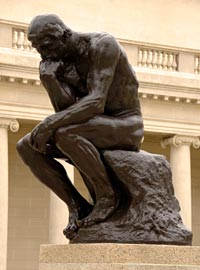Rodin Retrospective at the Frist
 The Thinker, by Auguste Rodin
The Thinker, by Auguste RodinPhotograph by Andrew McMillan
The Frist Center for the Visual Arts debuts Rodin: A Magnificent Obsession on Sept. 12, featuring more than 60 bronze sculptures, from small studies to monumental works by Auguste Rodin (1840-1917). On view through January 4, the exhibition illustrates the artist's innovative contributions to modern sculpture, spanning the length of Rodin's career through renowned works such as The Thinker (1880) and The Kiss (1881-82). The largest and most comprehensive private collection of works by Rodin, the exhibit features portraits, maquettes, partial figures and hands by the artist. Supplemental items including works on paper, photographs, portraits of the artist and a film about The Gates of Hell are on view as well.
In his teens, Rodin attended the government school for craft and design, where he learned to draw plaster casts of ancient sculpture and to model in clay. Although he sought admission to the prestigious École des Beaux Arts, he was rejected three times. Rodin's struggle for recognition dominated his early career. During the 1860s Rodin submitted his work to the annual juried Paris Salon exhibitions-the most important shows of their day-but suffered a series of rejections. In 1877 his work was finally admitted to the Salon. Significant early works, such as Mask of the Man with the Broken Nose, and Bust of Jean-Baptiste Rodin, Rodin's earliest portrait and first known sculpture of his father, are included in the exhibition.
During Rodin's time, the most highly regarded sculptures were projects created for public places, because they were thought to have universal rather than personal meaning. Rodin received his first public commission in 1880 to create a sculptural entrance for a new museum of decorative arts in Paris, which ultimately was never built. The Gates of Hell featured hundreds of figures modeled in low to high relief and in the round. The imagery was inspired by Dante Alighieri's Inferno, which was part of The Divine Comedy—an epic poem written about 1308 that depicted the author's fictional journey through Hell and Purgatory to Paradise. Rodin's environment of tormented souls represents not only the underworld but also the suffering of humankind in general.
At the peak of his career, Rodin was regarded by some as the greatest sculptor since Michelangelo. He devised his own expressive language, conveying the vitality of the human spirit through a vigorous modeling technique that emphasized his personal response to the subject. Linking the French academic tradition, which idealized the human form, with the experimental ethos of modernism, Rodin frequently achieved a dynamic interplay between stasis and movement. In many of his sculptures tension is created by contrasting highly refined aspects of human anatomy and areas of unfinished clay or marble, an approach he admired in certain of Michelangelo's works. Rodin's reputation as the leading sculptor of his time led to such major commissions as The Gates of Hell, Burghers of Calais, and Monument to Honoré de Balzac.
" A Magnificent Obsession enables visitors to explore his genius in far greater depth, to understand the sources and concepts that inspired Rodin's passionate outlook on life, which may in turn inspire us as it has so many people around the world," says Mark Scala, chief curator at the Frist Center.
Resources:
Also in this Issue:
- Discovering Alexander Calder's Wearable Sculpture Jewelry
- Thing 1, Thing 2, Bronzed Anew: The Dr. Seuss National Memorial Sculpture Garden
- Patience Required: Chasing Copper and Silver
- Rodin Retrospective at the Frist
